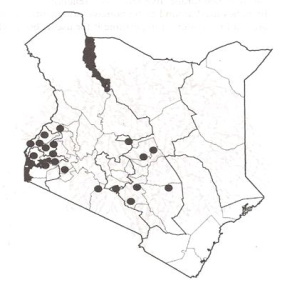Scientific name
Markhamia lutea
Order / Family
Bignoniaceae
Local Names
Embu (Muu); Kamba (Kyoo); Kikuyu (Muu); Luhya (Olusiola); Bukusu (Kumusoola); Luo (Siala); Meru (Muu); Nandi (Mobet); Somali (Sogdu); Turkana (Ekokwait).
Introduction
General Distribution:
It is native to Ethiopia, Kenya, Tanzania and Uganda. It is tropical African tree common in the Lake Basin and highland areas, up to 2,000 m above sea level.
 |
| Distribution of Markhamia lutea in Kenya |
| © Maundu P. and Bo Tengnas. (2005). Useful trees and shrubs for Kenya, World Agroforestry Centre. |
General Information about the Tree:
The species is widely used in western Kenya. The wood is fairly termite resistant.
Biophysical Limits:
It stands acid heavy clay soil, but not water logging; prefers red loam and has deep roots. Altitude is 900 - 2000 m, Mean annual temperature: 12 - 270C, Mean annual rainfall: 800 - 2000 mm and it flourishes in agro-ecological zones II - III.
Propagation and Tree Management
It is propagated by use of seedlings and wildings. It grows fast and coppicing may be employed in their management. They take between 15 - 30 yrs to mature and may be found in plantations, amenity gardens and agroforestry systems. Plants can attain growth rates of more than 2 m/year. They should be planted in a deep hole, as the roots are long. Trees can be pruned and pollarded to reduce shading and are coppiced when they are about 1.7 m in height. Pods should be collected from the trees after they turn grey.
Products:
- Apiculture: M. lutea provides good bee forage.
- Fuel: Trees are a source of firewood and produce good charcoal. Fuel wood is used to cure tobacco in western Kenya.
- Timber: The wood, which is fairly resistant to termites, is used for furniture, poles, posts, tool handles and boat building.
- Medicine: Leaves are known to have medicinal value.
- Other products; walking sticks, banana props and mulch.
Services:
- Erosion control: Recommended for use in soil-conservation.
- Shade or shelter: The species provides useful shade and acts as a windbreak.
- Soil improver: It provides mulch, which enhances soil-moisture retention and increases organic matter.
- Ornamental: Attractive and worth planting as a screen or background tree for gardens and on golf courses.
- Boundary/barrier/support: M. lutea poles can be used as props to support banana trees.
Pests and Diseases
Young trees are often attacked by shoot borers, which cause crooked stems.
Information Source Links
- Maundu P. and Bo Tengnas. (2005). Useful trees and shrubs for Kenya, World Agroforestry Centre. ISBN-9966-896-70-8
- www.worldagroforestry.org
